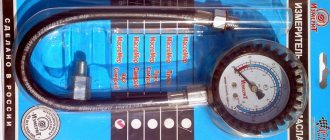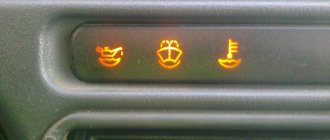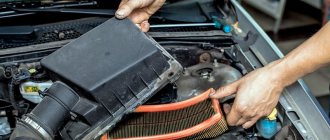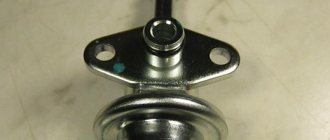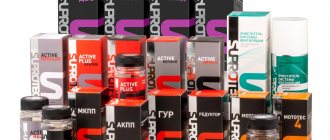The main causes of low engine oil pressure
Reduced engine oil pressure in the engine can be caused by the following reasons:
- The engine was filled with low-viscosity engine oil that was not suitable for long-term use. A product of this quality in most cases is a fake of poor quality.
- Engine wear, which manifests itself in increased gaps between the bearings and the engine crankpins.
- Wear of the internal surface of the pump and, in connection with this, the inability of such a pump to create the necessary engine oil pressure.
- Significant wear of the cylinder-piston sector, where significant gaps appear between the piston and cylinder. In view of this, oil flows from the walls at a higher speed, which leads to a decrease in oil pressure.
The most popular additives for increasing oil pressure
Many motorists use compression additives from Hado. The specialists of this company have created a whole line of fairly efficient additives that can effectively combat the causes of low compression of the unit. Here are the characteristics of several of them.
Atomic metal conditioner (Xado Maximum)
The product has the following features:
Gel-Revitalizant (Stage Magnum)
It has the following positive features:
Additive for cleaning the engine oil system Xado Atomex Totalfish
The use of this additive provides:
In addition to the brands listed above, there are many different additives developed specifically for a specific type of engine and car make to increase oil pressure in the engine. Therefore, before purchasing them, you need to consult with sales representatives. And it is very important to purchase additives in branded stores so as not to buy counterfeits and thereby cause serious harm to your car.
Source
Reasons for increased engine smoke
Before moving on to a review of the characteristics and effectiveness of specific products, we will briefly discuss the mechanism of operation of smoke additives, since most of them are very similar, both in composition and in their effect on the engine. But in order to choose the right additive that would help against smoke, it is necessary to find out why thick black or blue smoke may come out of the exhaust pipe of a car. So, the cause of significant smoke may be:
- Wear of elements of the engine cylinder-piston group . In particular, we are talking about the breakdown of the cylinder head gasket, wear of the oil scraper rings, changes in the geometry of the cylinders and other malfunctions due to which oil enters the combustion chambers and is burned along with the fuel. Because of this, the exhaust gases become dark and their quantity increases.
- Engine aging . At the same time, the gaps and backlashes between the individual elements of the CPG and other systems increase. This can also lead to a situation where the engine will “eat up” oil, and similarly there will be a large amount of black (or blue) exhaust gases.
- Incorrect selection of engine oil . Particularly if it is very thick and/or old.
- Leaking seals . Because of this, oil can also enter the combustion chamber or simply onto hot engine elements and fry. However, in this case, smoke will most likely come from the engine compartment.
As a rule, an increase in the amount of exhaust gases (both gasoline and diesel engines) occurs in old and/or very worn engines (with high mileage). Therefore, with the help of additives you can only temporarily “mask” the breakdown, but not get rid of it.
What kind of engine additives are there?
The additive is one of the ways to increase engine power. Thanks to the wide range of reductants available at specialized points of sale of auto products (shops, markets, service stations), it is difficult for the driver to decide on the choice of cleaning agent. There can be several reasons for engine oil consumption. These are deformation of the cylinders, worn piston rings, insufficient viscosity of the engine oil, engine overload and many others. But common ones are clogged oil and excessive wear of rubbing surfaces. To eliminate them, various restoring liquids are used, which are added to the lubricant.
However, the popularity of additives entails the production and sale of low-quality products, which can harm the efficient operation of the car. Therefore, it would be a good idea to familiarize yourself with the main functions of additives and find out their pros and cons.
Remetallizant substances
The additives contain particles of soft metals (copper, bronze, tin), which help create a protective layer under mechanical stress. Such products include products from such manufacturers as Rimet, SURM, Resurs, Fenom, MS-1000.
The positive factors of reducing agents are:
Improved compression in cylinders;
· reduction of consumption of fuels and lubricants;
· the protective layer is formed quite quickly;
· low cost of the product, especially domestic production.
Flaws:
· the protective film has low wear resistance;
· for high-quality engine operation, it is necessary that the oil always contains a remetallic agent;
· when replacing the lubricant, the further effectiveness of protection decreases sharply;
· the result from using the additive may be unstable and may not meet the wishes of the car owner.
Teflon-containing preparations
Created on the basis of Teflon and ensure the creation of a protective layer on the surface of rubbing parts. Teflon is a rather slippery substance, and the film formed on the surface acts as a heat insulator, which negatively affects the removal of heat from friction points. Therefore, there is no clear idea of how the drug will behave in a particular car.
Negative aspects of the additive:
· high cost of the product;
· mandatory use after changing the oil in the system;
· fragility of the protective layer;
· “does not like” high temperatures, is susceptible to decomposition;
· when filling once, requires constant presence in the oil system;
· the presence of Teflon negatively affects exhaust gas performance. The concentration of phosgene increases sharply. The use of the drug is limited in Western Europe, Canada and the USA;
· entails coking of the pistons and the appearance of carbon deposits on the walls of the combustion chamber.
The following companies are involved in the creation of Teflon-containing preparations: Lubrilon, Liquid Ring, Matrix, Slick 50, Petrolon, Microlon.
Metal conditioners
The molecular structure of the substance includes chlorine and sulfur compounds, which accelerate the process of dissolving wear products of metal surfaces, turning them into salt. Next, the part is restored by returning the salt to the metal surface. Due to the fluorinated polyesters contained in the additive, the rubbing mechanical parts are cladding. To prevent polymers from contributing to the formation of carbon deposits in the combustion chamber, cleaning elements (alcohols, ethers) are added to the reducing agent.
Advantages:
· sharply reduces engine wear;
· high cladding of contacting surfaces.
Flaws:
· toxic and banned in some European countries;
· the protective layer is destroyed when exposed to high temperatures in the combustion chamber;
· Requires constant presence in engine oil.
Companies producing similar drugs: Fenom, SMT2, Hi-Gear, Xado, ER.
Layered Friction Modifiers
The drug is produced on the basis of particles of graphite, tungsten, molybdenum, due to which a protective surface is formed in several layers. Such additives have more negative aspects than positive ones:
· unstable protective ability of the layer
· fragile coating loses its qualities at low concentration of the product in the oil system
· has a high rate of destruction of the protective film when exposed to high temperatures
· graphite particles contribute to the formation of unwanted deposits on the walls of the combustion chamber, pistons and valves.
Companies producing such additives: Liqui Moly, Xenum.
Friction geomodifiers
These additives contain serpentine, which includes various chemical elements (magnesium, graphite, amphibole and forsterite). The compound tends to emit high temperatures when friction occurs. The metal becomes softer and microparticles of chemical elements are introduced into it, forming a metal-mineral structure. The protective layer is characterized by increased strength and abrasion resistance.
Other advantages:
· the protective cover is similar in structure to a metal surface;
· with a sharp change in temperature from “plus” to “minus”, the resulting film does not chip;
· the duty cycle of engine oil increases, eliminating its rapid production;
· acts as a dielectric, wear-resistant;
· not affected by corrosion and oxidative processes;
· allows you to renew the worn surface of parts and improve its efficiency.
Disadvantages of geomodifier:
· does not work on engines with aluminum liners.
Produced by manufacturers Suprotek, Forsan, Rys-Master. They are considered the best additives for high mileage engines.
Some features of the use of regenerating agents for gasoline and diesel engines:
· on diesel engines, additives can increase the flammability characteristics of the fuel and reduce the likelihood of deposits appearing in the cylinders;
· increases resistance to detonation of gasoline engines.
Signs of loss of compression
Symptoms of low compression may include:
- increased fuel and oil consumption, rapid onset of oil starvation due to untimely maintenance;
- reduction in engine power at low speeds;
- blue or gray exhaust smoke due to rapid contamination of the combustion chamber;
- unstable operation of 1 or several cylinders at low speeds;
- launch difficulty.
The compression value characterizes the force of compression of the fuel-air suspension in the cylinders. For a standard engine, weak compression is noticeable at low speeds and cold weather starts.
For diesel engines, the decrease in the indicator is more critical, because ignition of the fuel in them occurs due to sudden pressure.
Principles of action of additives
The automotive market now has a huge selection of different additives based on their properties and operating principles. But before purchasing them, you need to clearly know that most of them can combat the consequences of certain problems:
- changes the physical and chemical structure of the oil;
- modifies and transforms worn surfaces of parts to reduce their level of friction;
- increases oil pressure for a while;
- prevent the formation of varnish and soot deposits;
- reduces thickening of automobile oil;
Before using additives...
Complex oil additive
There are a few things to think about before you add a specific compression compound to your oil. Firstly, about the quality of the lubricant, which is used to reduce friction between engine parts. So, if a motorist buys an expensive functional fluid from leading manufacturers, then most often this is a guarantee that the manufacturer took care of the presence of additives in the oil in advance. The second thing you need to pay attention to is the compatibility of additives with oils.
In general, there are additives suitable for any oil, but they are not so easy to find, because their quantity is limited, and they usually cost much more than single products.
So, compression restorers justify themselves only in cases with low-quality lubricants, and “exhausted” quality ones. In other cases, it is better to limit their use altogether in order to avoid disaster. Return to content
Types of additives in motor oils to increase pressure
First of all, among these, detergent additives should be highlighted. You can also find these in your city or in an online store under the name “detergent”. In general, the principle of their operation is that they do not allow soot and varnish deposits that appear in automobile oils as a result of their waste or oxidation to settle on important “transit paths” of the lubricant to the object of its envelopment. Such particles tend to collect into larger crystalline formations that attach to the walls of the engine crankcase, as well as to its moving mechanisms. These, if not stones, tear the oil film and increase friction between metal surfaces, causing them to wear out, crack, and sometimes even break.
In turn, detergent additives, due to the content of active heavy metal compounds, can break down harmful accumulations into oil-soluble particles. Also, the above-mentioned substances, when interacting with elastic liquids, create in them a certain acid-base environment, safe for the engine, but unfavorable for crystallized deposits, therefore, a high-quality detergent additive not only destroys existing “dirt”, but also prevents its further appearance.
Engine oil freezing
Another, no less rare reason why oil does not flow well to the engine components is its thickening. For motorists, this problem is not something unusual, because in the cold season the consistency of the oil can even turn into jelly. In most cases, motorists deal with this problem by using all-season lubricants, which already contain enough additives to ensure engine safety. However, for those who use low-quality oil or good oil whose properties have lost their expression, additives that restore the low-temperature viscosity characteristics of motor lubricants, so-called antifreeze, are suitable. In other words, too thick oil is unlikely to reach its destination quickly enough, and it will envelop the parts worse, but if it is made thinner, the compression will be restored, as will the oil film.
Another reason why fluid may not move well through the channels provided for it is a slight oil leak into the engine crankcase. Simply, a sufficient amount of lubricant will not reach its destination. In this case, you will need to fix the leak. If it is large, then you won’t be able to do without replacing oil seals or gaskets; they themselves are inexpensive, but the process of removing them is quite a task. Minor leaks can again be eliminated by special additives. Products that restore rubber and plastic surfaces of parts can increase their volume so that their sealing of holes becomes the same again. Of course, such compounds do not expand gaskets and seals to incredible sizes, so if they are severely damaged, compression will still not be restored.
There are additives that act as oil film substitutes. It is not for nothing that they are considered impractical, because they only save for a short time. In addition, the lubrication they provide is too ineffective. These products also belong to compression restorers, however, in practice they are not such at all.
And finally, probably every motorist has heard about multifunctional or complex oil additives. It is believed that they are even more effective than the previously described substances, because they restore compression in all the above-mentioned ways, and also protect the engine from corrosion, reduce its noise, exhaust toxicity, etc. But despite this, experts do not recommend “indulging” in such means. The fact is that research results indicate that the composition of the additives included in their composition is poorly balanced. Simply put, additives packed into one bottle often conflict with each other, having a negative effect on the metal surfaces of the engine and the oil. But, fortunately, this does not happen too often. Return to content
Tips and tricks
So, if you decide to use an oil thickener on your engine, then the power unit may work relatively well for a while, but in the future, repairing that engine may cost much more.
It turns out that this solution is more suitable for internal combustion engines, which are actually “living out” their last days, and there are no plans to restore such a unit in the future for one reason or another.
By the way, various nanoceramic compounds and remetallizants (metal reducers) not only make the oil more viscous, but also form a characteristic layer on the surfaces of engine parts. Even taking into account the fact that such a layer reduces the gaps in the CPG, provides protection and reduces friction, at the same time, heat transfer inside the power unit deteriorates.
This means that under load or at high speeds, local overheating may well occur. Often, such deterioration in cooling leads to engine detonation, melting of pistons, burnout of valves, etc.
It becomes clear that if the owner intends to repair the engine later (a rebuild or overhaul is planned), then the use of oil thickeners and other similar compounds is highly not recommended. You should limit yourself to regular topping up of base oil suitable for the given engine. We add that in cases where the waste consumption is too high, you can change the type of oil used to one of the most viscous options.
In this case, this option must be indicated in the list of acceptable oil viscosities for a particular internal combustion engine. In other words, if the manual says that in a particular engine you can use both 5W30 and 10W40 oil, then it is quite possible to switch to a more viscous lubricant with the 10W40 index, without the risk of severely harming the power unit.
Motor oil thickeners: what you need to know
So, as mentioned above, motor oil thickeners are special compounds that can effectively increase the viscosity of the base lubricant.
Products from different manufacturers may differ in their chemical basis, have unique components, etc., but their general principle of action is similar.
The products may have visual and structural differences, some are yellow and quite thick, others are greenish-gray and more fluid, and others may be completely transparent. The names may also differ. As a rule, the emphasis is not only on the fact that it is a “thickener” for the oil.
More often, additives are called protective-restorative complex metal conditioners, friction modifiers (geomodifiers), revitalizants (remetallizant), etc.
Depending on the components, certain products may contain tiny particles of various minerals and other additives. Marketers usually call such compositions protective additives with metal-ceramic additives (nanoceramic additives). For example, additives to motor oil containing molybdenum (molybdenum additives) are well known.
Let's return to the “thickeners”. As you know, during the operation of an internal combustion engine, oil is supplied to many parts not only under pressure, but also by splashing and gravity flow. This allows the parts to be properly lubricated, since the crankshaft and other moving components actively spray a sufficient amount of lubricant. It is also quite obvious that the thinner the oil, the more intense and faster it sprays.
We also note that if the engine is in order, then the lubricant practically does not enter the combustion chamber, since the excess is “removed” from the cylinder walls using oil scraper rings, and the valve seals reliably hold the lubricant during timing operation.
However, we should not forget that during the operation of the engine, the cylinder-piston group, crankshaft, timing gear and other components and parts wear out. As a result, the gaps between the cylinder wall and the piston increase, the piston rings “lie down” and lose mobility, wear out, and become covered with soot. Also, valve seals become less elastic, etc.
Such wear of various elements leads to a large amount of lubricant entering the combustion chamber, the engine begins to consume oil and smoke blue oil smoke. As experienced drivers and auto mechanics say, increased oil loss begins.
It becomes clear that if you make the lubricant thicker, the fluidity of the oil will decrease, the intensity of its splashing will also decrease, and the oil film will thicken. The result will be a reduction in oil consumption due to waste, stopping oil seal leaks, increasing compression and the disappearance of blue smoke from the exhaust pipe.
However, it is important to understand the following: this effect will be very short-lived. Suffice it to remember what was said at the beginning of the article - each manufacturer designs the engine to run on oil with a strictly defined viscosity index. The use of other lubricants, both more and less viscous, naturally worsens the lubrication of loaded parts and assemblies.
In simple words, after using a thickener, the engine stops smoking and “eating” oil, but the overall wear of the engine increases significantly. At the same time, protective additives, nanocomponents and additional friction modifiers in the additive are also unable to seriously interfere with this.
If we add that the power unit into which anti-smoke additives are poured is itself usually already worn out, then we can soon expect a quick and complete failure of such an engine after adding an oil thickener.
Currently reading
How to maintain and charge a maintenance-free type of battery for...
ZIL 130 engine: a legend of the Soviet automobile industry
Rational method of increasing pressure
If the compression in the engine has decreased, you need to use one of the methods to increase the pressure. There are high quality and effective enlargement supplements available. When using them, the compression of the oil in the engine rises and is maintained at an optimal level.
What additives are most common today?
- Atonium. It is a metal nano-optimizer. This tool optimizes the contacting parts to the maximum. It penetrates metal parts by one and a half millimeters. The properties of friction pairs change. The formed layer is multifunctional, provides increased protection and high strength to spare parts. Use Atonium constantly to increase engine power and reduce fuel costs.
- Fuel additives. They are added to the fuel tank. This makes it possible to increase the performance of the power unit. They are divided into oxygen-containing and oil-based. The amount of emissions decreases, the octane number increases. This ensures good combustion. The bases are essential elements and alcohol.
Fuel additives
High-quality oil additives significantly reduce engine wear and increase pressure. They molecularly restore the surfaces of contacting parts. The ceramic layer is resistant to high temperatures. It performs microscopic alignment of worn parts and filling of cracks. The cylinder walls are leveled and remain sealed. Additives remain effective for approximately seventy thousand kilometers. During this time, the lubricant can be replaced several times.
It is possible to increase blood pressure using various methods. If the car owner finds it difficult to choose, you need to consult a specialist. You can measure your blood pressure yourself. You need to warm up the engine, open the air filter, unscrew the spark plugs. Failure usually occurs due to cracking, deformation of piston rings, and valve malfunctions.
The most common types of additives
Metal nano-optimizer – Atonium.
This substance perfectly optimizes the friction of the surfaces of contacting parts. The substance has the ability to penetrate into all parts by 1-1.5 mm. This changes the chemical properties of the vapor. A multifunctional layer is formed on the surface of the parts, providing reliable protection and increased strength of the parts. Regular use of Atonium helps increase engine power and reduce fuel consumption.
Fuel additives
These substances increase engine performance and are divided into oil and oxygen-containing substances.
Oxygen-containing additives are oxidized by oxygen and stimulate an increase in the octane number of the fuel. In connection with such processes, compression increases and the volume of harmful emissions decreases.
Oil-based additives work more effectively, although they are quite expensive. They are more profitable to use on heavily worn engines, as they create a dense ceramic layer on the surface of the rubbing elements. This layer is quite resistant to high temperature changes.
This type of additive removes all irregularities at the molecular level and therefore increases the level of compression in the cylinders. The effect of such additives lasts for 60-70 thousand km. mileage
When using such additives, the following transformations occur:
- the amount of exhaust is reduced;
- octane number increases;
- the quality of fuel ignition improves.
The active ingredients of such additives are alcohols and ethereal elements.
The most popular additives for increasing oil pressure
Many motorists use compression additives from Hado. The specialists of this company have created a whole line of fairly efficient additives that can effectively combat the causes of low compression of the unit. Here are the characteristics of several of them.
Atomic metal conditioner (Xado Maximum)
Recommended for use to restore engine compression. The active ingredient is a three-component product consisting of a complex metal conditioner with the addition of revitalizant (3rd generation).
The product has the following features:
- localizes and subsequently restores the worn surface of moving parts;
- compression increases and stabilizes;
- in the oil system, the engine oil pressure increases to the optimal level;
- protects parts from excessive overloads and overheating;
- improves the quality of engine oil and reduces fuel use;
- Ideally compatible with all existing types of oils.
Gel-Revitalizant (Stage Magnum)
The gel is recommended for cars with high load capacity and diesel engines. The latest development using the latest generation (3rd) revitalizant, which is distinguished by its single-stage nature and increased protective properties.
It has the following positive features:
- restoration of the worn surface of engine rubbing mechanisms;
- creation of a protective system for parts of the unit that protects them from premature wear, as well as overloads;
- increasing engine compression to optimal parameters;
- reduction in fuel consumption rates;
- increasing the power and service life of the unit;
- increase in the period of operation of parts by 2-3 times;
- compatibility with all types of oils.
What do you need to know?
Objectively assessing the advisability of using additives in motor oils, it should be emphasized that many negative reviews about their use are not unfounded. This attitude towards additives is, by and large, dictated by the fact that users have superficial knowledge about these products. However, these compositions do have both advantages and disadvantages, some of which are quite significant. So why do people buy them? It’s just that the harm in some cases is proportional to the benefit of their use.
For example, additives for increasing oil pressure contain substances whose evaporation in large quantities is a terrible poison for the human body. They can cause severe poisoning with dizziness, vomiting, muscle spasms, and hallucinations. In extremely rare cases, they lead to death.
It has been proven that detergent and stop-flow substances do not have such properties. That is, they are completely safe for motorists, others, and, of course, engines. However, they negatively affect the resistance of the liquid receiving them to oxidation. They also increase the likelihood of engine parts rusting. On the other hand, all this can be overcome by adding detergent additives and anti-corrosion inhibitors. It would seem that in this case the pressure will definitely be restored, but the combination of the last two additives in one oil is usually accompanied by the formation of even more sediment in the engine than before. And yet, there is a way out; you can look for combined means to increase blood pressure that combine the necessary functions.
Remember that any of the above additives only briefly delays the inevitable repair, and none of them can eliminate the problem completely.
Return to content
Engine additive - what is it and why is it necessary?
There are many reasons for high engine oil consumption. One of them is wear and tear on the moving parts of the engine, which negatively affects the dynamics of the vehicle. Restoring engine efficiency is easily accomplished with an additive. This is a liquid product that is added to engine oil and helps improve the technical performance of the car. When the additive is poured into the oil system, a mineral compound is formed. Under the influence of high temperature and pressure in the system, monoparticles appear on the surface of the moving parts, which perform the restoration function.
The damaged surface is reanimated and works effectively for a long time. Car engine additives are divided into several types, which are:
· increase the viscosity of the lubricant;
· act as an additive;
· have anti-friction abilities;
· slow down the aging process and wear of parts;
· are antioxidants;
· have a preservation effect.
The use of engine regenerating agents helps extend the life of the engine. For the product to work effectively, you must first flush the engine.
This procedure is also useful in the following cases:
· when replacing old oil;
· if it is necessary to fill in a different type of lubricant;
· dull knock in the engine;
· when the system is clogged;
· the engine consumes oil, but does not smoke;
· after major work on the engine.
The engine is flushed using two methods: using special means (additives) or a flushing composition. The latter is used in cases where it is necessary to drain the used lubricating fluid and fill in a different type of oil. Additives are poured directly into used motor oil. They are ineffective and cannot completely rid the engine of highly concentrated elements.
To clean the engine from harmful compounds that negatively affect the performance of the engine, there are decarbonization products.
With their help, the piston rings, as well as the walls of the combustion chamber, are cleaned. There are several types of decarbonization: soft, hard, and cleaning while the car is moving. The third cleaning option is very convenient, when an additive is carefully added to the oil and works effectively in the working movement of the engine. Only after a long period of 200-300 km, the lubricant is changed to a new one. During severe decoking, the cylinders are cleaned. The liquid is poured into the sleeves and kept for some time. After which the reagent is drained. At service stations, the hard cleaning method is more often used.
Let's sum it up
As you can see, additives, thickeners and additives in motor oil are capable of providing the declared effect to one degree or another, but it will be short-lived. Moreover, the consequences for the engine after using various compounds may well be quite serious.
In some cases, such an engine in the future simply becomes impractical to restore in economic terms, that is, it is more profitable and easier to purchase a contract engine (make an engine swap).
This allows you to further sell the car at an inflated price, which in reality does not correspond to the technical condition of the vehicle.
How to measure engine oil pressure
Some vehicles are equipped with a stationary gauge that displays operating oil pressure on the instrument panel. In the absence of one, you must use a special pressure gauge. In order to measure oil pressure, the following operations must be performed.
- Warm up the engine to operating temperature 86–92 °C.
- Turn off the engine.
- Unscrew the emergency oil pressure sensor from the engine block.
The sensor is completely unscrewed from the engine housing after disconnecting the wire from it - Install the pressure gauge hose using the adapter fitting instead of the oil pressure sensor.
The pressure gauge fitting is installed instead of the unscrewed emergency oil pressure sensor - Start the engine and measure the oil pressure at idle speed.
- Changing the crankshaft speed to medium and high, record the pressure gauge readings at each stage.
Oil pressure varies in engines of different models, so the range of its operating indicators must be looked for in the technical literature for a specific car model. But if these are not at hand, you can use averaged data corresponding to the normal operation of the engines.
Table: average oil pressure in serviceable engines
Accordingly, if the indicators go beyond those given in the table, then you should contact a specialist or take action to eliminate the malfunction yourself.
Before starting repairs, the oil pressure must be measured to make sure that the primary signs are correct.
Video: measuring oil pressure in a car engine
Motor oil can be compared to the blood in a living body - it plays a fundamental role in the functioning of all organs, just like the oil for the mechanisms in a car engine. Carefully monitor the condition of the oil in the engine, regularly check its level, monitor for chip impurities, monitor the mileage of the car, fill in oil from a trusted manufacturer and you will not experience problems with oil pressure in the engine.
- Author: Anton Sukhorukov
Anton. 35 years. Married with children. Rate this article: (3 votes, average: 3.7 out of 5)
Increased oil consumption
Many car owners are faced with increased engine oil consumption. There may be several reasons for this:
- Using the wrong engine oil.
- Long-term downtime of the car, during which the working fluid has lost its properties.
- A breakdown that causes a leak.
- Aggressive driving style.
If the cause is not a malfunction, engine additives can be used to reduce oil consumption. It is worth noting that these products will only be truly effective in new engines or with relatively low mileage. In units with severe wear, no additives will help.
A special composition allows you to achieve reduced consumption; as a rule, it is a synthetic molybdenum-organic complex with microceramic particles. The additive creates a durable protective layer that is resistant to mechanical stress, fills microcracks, and also eliminates other defects. An anti-oil additive can also slightly reduce fuel consumption.
There is an oil additive for decoking oil scraper rings, the use of which is necessary to remove fuel combustion products. Of course, you can disassemble the motor and then carry out a thorough cleaning of all components, but if you do not have time for this, then such additives can be used for prevention.
An oil additive for decoking piston rings performs several tasks at once: it reduces engine oil consumption and can also increase compression. It is worth considering that such products only delay the need for full cleaning or repair.
Choosing additives for engine oil
Today, on the shelves of auto stores there are a large number of liquids that help extend the life of a car engine. One of these means is oil additives for a diesel engine or gasoline engine. Such additives perform a wide variety of functions and can reduce or increase the viscosity of the lubricating fluid, clean and protect surfaces from corrosion and other deposits. There are additives that prevent oxidative processes, reducing compounds and many others. However, you should not rely entirely on supplements, as they have not only advantages, but also their disadvantages.
Even the best engine additive is not needed if your car is in perfect condition and was just purchased from a car dealership. In this case, using supplements is as logical as filling perfectly healthy teeth for a child. Therefore, when operating a new car, it is enough to promptly change the engine oil and coolant and use new oil filters every time you fill the lubricant. But if we are talking about a car with a mileage of more than 100,000 kilometers or a used car whose engine condition is in doubt, then additives can be very useful and sometimes necessary. The most effective of them are considered to be remetallizants, which have the most beneficial effect on the engine.
To determine which additive is best to pour into the engine, we will consider good (and not so good) compositions.
Leak formation
Over time, the system loses its novelty, so it begins to leak in some places. This especially often happens due to valve stem seals. They lose their elasticity, which leads to leaks. It is worth immediately noting that such malfunctions must be eliminated through repairs. No additive will solve this problem.
Why are they then necessary? They are used for short-term effects. If you went on vacation or to another city and discovered a leak, it is usually not possible to fix it promptly. But this composition will help you reach the garage or service station. Regular use of such additives can adversely affect engine parts and disrupt its operation.
Products for worn out engines
If your car has already driven more than 100 thousand kilometers, an engine oil additive for worn-out engines is suitable for you. During operation, the gaps between parts increase, the metal gradually wears out, and the engine loses power. Wear can also lead to the problems described above, i.e. increased oil consumption or loss of compression. Restoration additives will help to partially extend the service life of the unit.
This group also includes molybdenum oil additives. Additives allow you to create a thin layer on rubbing parts, which prevents direct contact of metals. They will further prevent the appearance of microcracks and scuffing. Such additives will save drivers from many engine problems.
Potential additive hazards
Despite the numerous positive effects of additives, many drivers have a negative attitude towards their use. This is completely justified. Motor oil manufacturers are large corporations that spend enormous amounts of money on research and production. Modern oils already contain a large package of various additives. They are able to effectively perform all the necessary functions (provided that the oil is of proper quality).
The additional additives used may conflict with the oil composition, resulting in low or no effectiveness of both compositions. If you use original oil from the manufacturer and change it in a timely manner, then the use of additives is not required. Their use is justified if the oil is already quite old or you bought a product of average quality that does not cope with any of the tasks, then additives can be used to “help”. It is strictly forbidden to use several additives at the same time.
If problems occur, repairs must be carried out. Supplements will only delay this procedure, but will not save you from damage.

